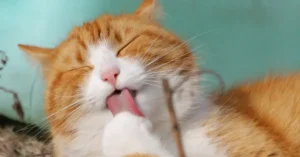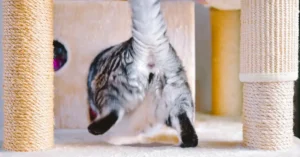Understanding the most aggressive cat breed is not just about labeling them as difficult; it’s about appreciating their unique characteristics and learning how to coexist with them harmoniously.
These cats often exhibit a strong, independent personality, coupled with a territorial instinct that can sometimes translate into feisty behavior. However, with the right approach, patience, and understanding, they can be just as affectionate and loyal as any other cat.
In this exploration, we’ll dive into the world of these misunderstood felines. We’ll uncover what makes them tick, how to manage their spirited nature, and most importantly, how to appreciate the beauty and complexity of the most aggressive cat breed. After all, every cat, regardless of its temperament, deserves love and a chance to be understood.
Understanding Feline Aggression
We often marvel at the range of cat breeds, from the hypoallergenic to the most common ones, and even the famed Garfield breed of cat. But today we’re focusing on the aspect of feline behavior that can be quite concerning: understanding the most aggressive cat breed. Let’s dive into what causes those hisses and swipes.
The Role of Genetics in Aggression
Genetics play a pivotal role in a cat’s predisposition to aggressive behavior. Similar to how each cat breed has unique physical traits, behavioral tendencies like aggression are partly hereditary. For instance, some breeds display a higher tendency towards territorial aggression, with Siamese cats often cited for their assertive and sometimes jealous nature.
Behavioral Signs of Aggression
Spotting behavioral signs of aggression is crucial in understanding and managing our feline friends. These include:
- Tail flicking
- Hissing or growling
- Flattened ears
- Dilated pupils
- Spiky fur
Expressions of play aggression could also be misinterpreted. It’s essential to differentiate between play and hostility.

Environmental Factors Influencing Behavior
Environmental Factors can significantly impact a cat’s behavior. Cats are sensitive to their surroundings, and stressors like a change in living situation or introduction to new pets can trigger aggression. Ensuring a consistent and calm environment can help mitigate aggressive behavior. Elements like proper socialization and the introduction of calming products can be effective in adjusting a cat’s demeanor.
Traits of Aggressive Cat Breeds
When exploring the feline world, it’s fascinating how varied cat breeds can be. Alongside the charming hypoallergenic and the ever-common breeds, we find the enigmatic figures of the feline realm. As cat connoisseurs, we’re intrigued by the most aggressive cat breed, contrasting sharply with the laid-back temperament of a real-life Garfield. Let’s dive into the specific traits that may define an aggressive cat breed.
Physical Characteristics and Aggression
Aggressive cat breeds often exhibit distinctive physical characteristics. Consider the Bengal cat, a breed known for its remarkable energy and assertive nature. Cats that tilt towards aggression may possess a more muscular build, with large bodies that enable them to engage in dominant behavior. These felines typically showcase alert expressions, with ears positioned to react swiftly to potential threats.
Common Behaviors of Aggressive Breeds
When observing aggressive cat breeds, you may note a broad range of behaviors:
- Attacking: This may involve pouncing or leaping toward perceived threats or during play.
- Biting and Scratching: Used as defensive mechanisms, these are more pronounced in some breeds.
- Active and Playful: An excess of energy can sometimes manifest as aggressive play.
- Growling or Hissing: These sounds are clear indicators of discontent and a warning to back off.
Behaviors are not acts of malice, but expressions of instinct, intelligence, and sometimes, fear or stress. Understanding this can profoundly impact our interactions with these magnificent creatures, helping us to live harmoniously with even the most spirited of feline companions.

The Most Aggressive Cat Breeds
As cat enthusiasts, we’ve taken a keen interest in the behaviors and temperaments of various feline companions. Particularly, we’ve looked at some of the most aggressive cat breeds, each unique with their traits that can surprise even the most seasoned cat owners. Here we’ll explore breeds known for their high energy and assertive personalities.
Siamese: Vocal and Demanding
The Siamese cat is a striking creature, not only for its beautiful blue eyes and slender body but for its unmistakable vocalization. Siamese cats are exceedingly vocal and known for their demanding nature, often forming a strong bond with a single person. These Siamese cats can exhibit jealousy, and their territorial tendencies may require extra attention to prevent aggression.
Bengal: Wild and Energetic
With a lineage tracing back to wild ancestors, Bengals are a wild and energetic breed, which can sometimes be misinterpreted as aggression. Bengal cats need ample space to play and explore. They thrive on mental stimulation and physical activity to channel their high energy levels effectively.
Sphynx: Active and Affectionate
Sphynx cats, known for their hairless appearance, are full of energy and seek constant affection. They are highly active and love interaction. A Sphynx’s aggressiveness often stems from a lack of attention or stimulation, so interactive playtime is crucial for their well-being.
Scottish Fold: Independent and Territorial
The Scottish Fold is instantly recognizable by its unique folded ears. While they are known for being sweet and playful, they can also be very independent and territorial. Their personal space is important to them, and they might assert themselves if they feel their territory is threatened.
Aggression in cats can manifest in various ways—from vocal expressions to physical posturing. Understanding each breed’s characteristics can help us manage their behavior and provide an environment where they feel secure and stimulated.

Socialization and Behavior Management
When we consider the most aggressive cat breed, understanding how early socialization and professional intervention can shape better behavior is key. Let’s explore the essentials of nurturing a good relationship between owners and their potentially challenging furry companions.
Early Socialization and Training
Getting kittens off to a good start often means integrating them into their new environment with care and attention. Socialization for kittens should begin early, as their personalities are malleable and responsive to positive interactions. Consistent exposure to various stimuli, including people, pets, and new environments, can help kittens learn appropriate behaviors and reduce the likelihood of aggressive tendencies later on.
- Routine Play: Integrating regular playtime establishes healthy outlets for their energy and satisfies their demanding nature for mental stimulation and exercise.
- Handling: Gentle handling by different people can increase their comfort with human interaction, curbing future aggression.
Kittens who learn to associate human touch and interaction with positive experiences are less likely to develop problem behaviors. A playful kitten, given the right attention, is more likely to grow into a well-adjusted adult cat.

Professional Help for Aggressive Cats
Sometimes, despite our best efforts, an adult cat may exhibit signs of aggression that seem unmanageable. This is where professional help comes into play. Behaviorists or veterinarians can offer targeted advice and strategies customized to each unique feline.
- Analysis: A professional can assess if the aggressive behavior is due to medical issues or established behavioral patterns.
- Tailored Plans: They may suggest interventions such as environmental modifications or prescribe medications to manage stress or aggression in cats.
The relationship between a cat and its owner can significantly improve with understanding and intervention, even with breeds known for being more territorial or assertive. Remember, addressing aggression in cats requires patience and may benefit from professional insights.
Living with an Aggressive Cat
When we welcome the most aggressive cat breed into our homes, it’s our responsibility to understand and address their needs, ensuring they feel secure and harmonious within the household.
Creating a Safe Space for Cats
Aggressive feline behavior often stems from a lack of a safe space where they can retreat and feel secure. To mitigate this, we need to provide our furry friend with a dedicated area that’s solely theirs. This area could include:
- Climbing structures for them to ascend and survey their territory from a safe vantage point.
- Comfortable bedding in a quiet corner where they can unwind without disturbance.
- A selection of toys to keep them occupied and to allow an outlet for their instincts to pounce and play fetch.

Interaction with Other Pets and Children
Cats with aggressive tendencies can pose challenges when integrating with other pets and children. To ensure a smooth relationship between them, we should:
- Supervise interactions closely, especially during the initial stages of introduction.
- Teach children to recognize the signs of aggressive behavior in cats, like hissing or arching their backs, and to give the cat its space when these signs are evident.
- Provide separate territorial spaces for each pet to prevent conflicts and ensure each has a sense of ownership over their environment.
By understanding the unique needs of the most aggressive cat breeds and providing them with the proper space and training, we can create a peaceful coexistence for everyone in the family.
When Aggression Becomes a Problem
As we explore the nature of the most aggressive cat breeds, we must understand when that feisty spirit becomes more than just a quirk. Sometimes, the line between playful pouncing and problematic behavior can be thin, and recognizing when aggression needs addressing is essential for a harmonious home.
Seeking Advice from an Animal Behaviorist
When our furry friends exhibit signs of aggression that seem constant or intensify over time, we may be dealing with a serious behavioral issue. It’s time to consult an animal behaviorist who can provide specialized insight. These professionals assess behaviors like hissing, swatting, or biting and differentiate between what might be normal for a most aggressive cat breed and what signals distress or discomfort.

Identifying Triggers and Reducing Stress
Understanding the triggers that spark aggression is a critical step towards finding a solution. Aggressive behavior can be a response to feeling threatened or provoked, and recognizing these triggers, such as loud noises or environmental changes, can help us minimize stress for the cat. Creating a structured environment with consistent routines can provide a sense of security, reducing instances where the cat might feel stressed, jealous, or aloof. Additionally, providing hiding spots and quiet areas away from the hustle of household activity can be calming for cats that feel threatened or prefer to be alone.
Adoption Tips for Potential Owners
When it comes to bringing a new furry friend into your home, especially when considering the most aggressive cat breed, it’s crucial for us to look at not just the breed’s characteristics, but also how they match our lifestyles. This ensures a harmonious relationship where both you and your pet feel happy and attached.
Evaluating Breed Traits and Your Lifestyle
Adopting a cat is an enthusiastic decision, but it’s vital to consider if a hypoallergenic cat breed, the most common cat breed, or the most aggressive cat breed, like the infamous ‘Garfield breed of cat’, is the right fit for you. Here’s what we need to ponder:
- Energy Levels: Aggressive cat breeds often come with a bundle of energy. Are you able to dedicate time for play and interaction to match their spirit?
- Space: These cats may need more room to roam and let out their energy. Does your living space accommodate this?
- Personality Fit: Are you ready for a cat that may be more vocal and demanding than other breeds?
Consider not only your current lifestyle but also any long-term changes that could affect your ability to care for an energetic and possibly challenging cat.
Building a Lasting Bond with Your Aggressive Cat
Once you’ve decided on an aggressive breed, building a relationship with your new cat will take patience and understanding. Remember:
- Patience is Key: It may take time for your cat to become fully attached and comfortable in their new home.
- Training: Invest in training early on to manage any aggressive tendencies and establish boundaries.
- Consistent Routine: Maintain a routine that includes regular playtimes and quiet times, helping your cat feel secure and less inclined towards aggression.
By introducing structure and showing them love, you’ll forge a deep, rewarding bond with your pretty, audacious pet.

Our Toughts About The Most Aggressive Cat Breed
Often, when we hear about “aggressive” cats, there’s a mix of intrigue and a bit of wariness. But here’s the thing: labeling a cat breed as “the most aggressive” can be a bit misleading. It’s like saying a certain car is the fastest; sure, it might be true under specific conditions, but there’s so much more to the story.
First off, aggression in cats can stem from various factors like genetics, environment, and past experiences. Some breeds have a reputation for being more spirited or territorial, but it doesn’t mean they’re any less capable of affection or companionship.
Take, for example, breeds like the Siamese or Bengal. They’re often tagged as ‘aggressive,’ but talk to any owner, and you’ll hear stories of deep bonds and playful antics.
It’s essential to remember that ‘aggressive’ doesn’t equate to ‘bad.’ These cats often have a high energy level, intelligence, and a need for engagement. They’re not the type to laze around all day; they want to be part of the action, to interact, and to challenge their minds.
Yes, they might have a strong personality, but that’s just part of their charm.
So, our view on the most aggressive cat breed? They’re misunderstood. With the right environment, understanding, and a bit of patience, these cats can be incredible companions. They’re for those who appreciate a cat with a bit of spice in their personality, a feline who’s as unique as they are bold.
FAQ
What breed of cat is the friendliest?
The friendliest breed of cat is often considered to be the Ragdoll. Known for their gentle and laid-back nature, Ragdolls are typically very affectionate and enjoy being close to their human companions. They are known for their tendency to go limp with pleasure when picked up, hence the name “Ragdoll.” Other notably friendly breeds include Maine Coons, known as gentle giants, and Siamese cats, which are very sociable and vocal. However, it’s important to remember that individual personality can vary within any breed
What is the toughest cat breed?
If we consider physical strength and survival instincts, the Maine Coon is often regarded as one of the toughest. They are one of the largest domesticated breeds, known for their muscular build and robust nature. Originating from the harsh climates of New England, they are hardy and have a rugged disposition. However, in terms of temperament, they are quite gentle and friendly. It’s important to note that toughness in cats can also refer to resilience and adaptability, traits that many cats, regardless of breed, inherently possess.
What is the least aggressive cat?
The least aggressive cat breed is generally considered to be the Ragdoll. Known for their docile and placid nature, Ragdolls are often very gentle and are less likely to exhibit aggressive behavior. They are famous for their tendency to go limp in one’s arms, reflecting their easygoing and non-confrontational temperament. However, it’s important to remember that individual personality can vary within any breed.
If you also would like to know something about the Garfield breed of cat have a look at our article.
If you are curious about the Norwegian Forest Cat Breed it would be a pleasure if you read our article.
What are your thoughts about the most aggressive cat breed? Let us know in the comments.





